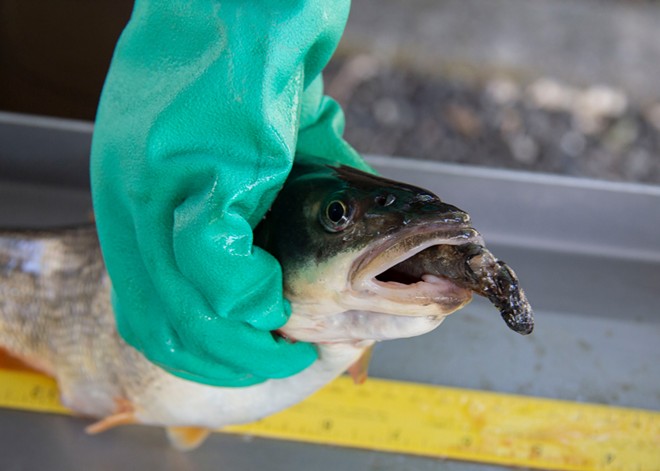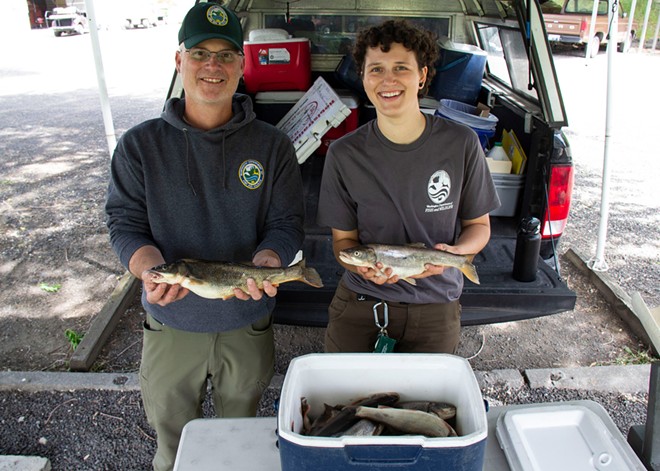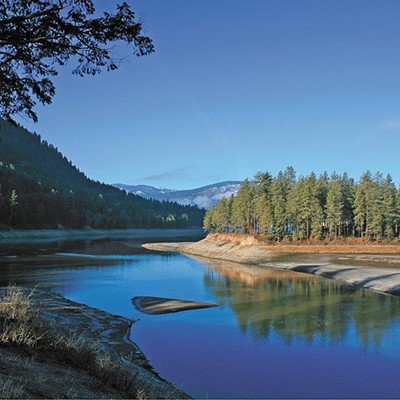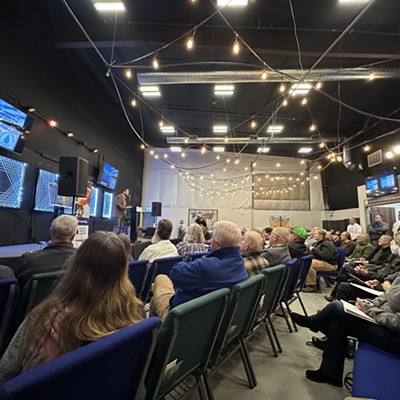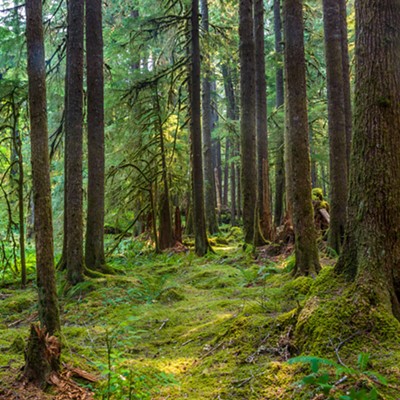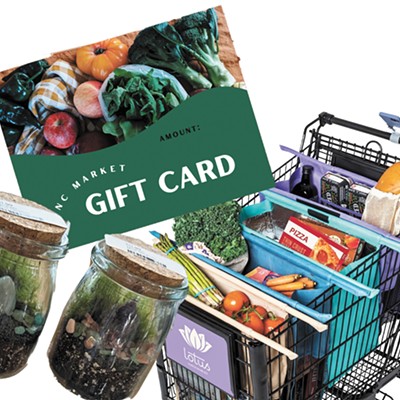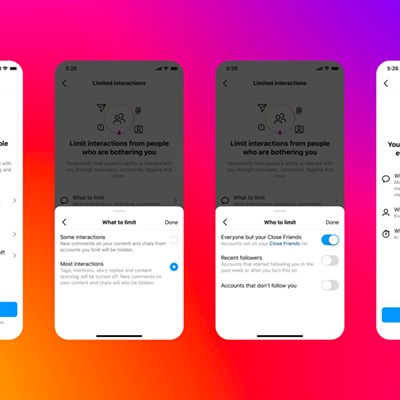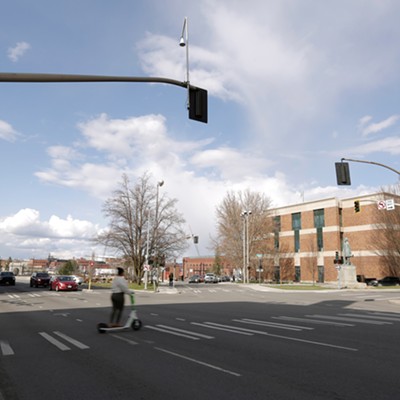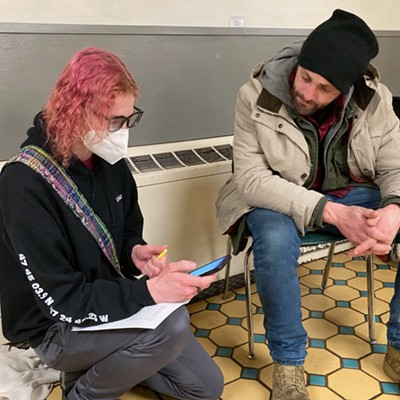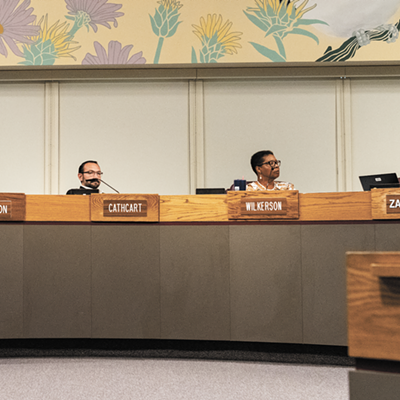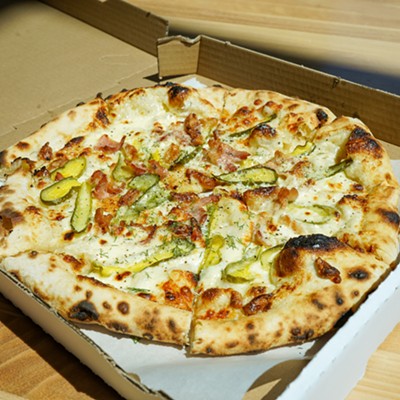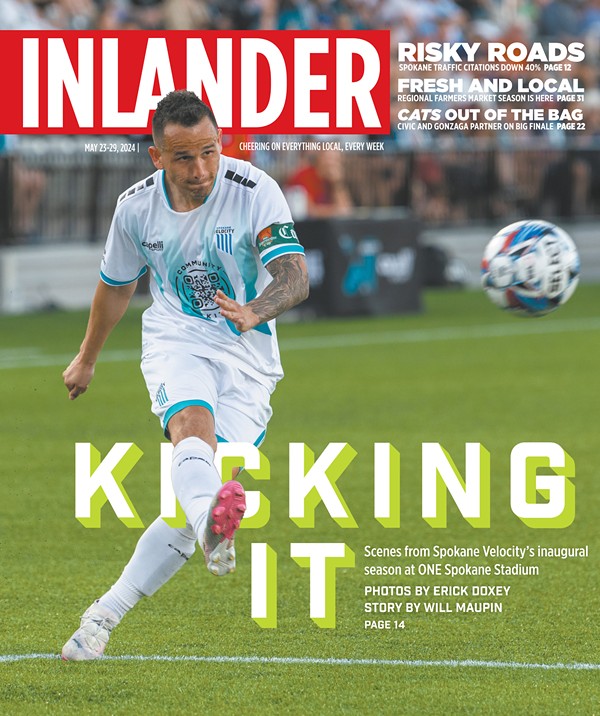It's 1 pm on a cloudless Tuesday in mid-May at Boyer Park and Marina, about a half hour south of Colfax. Joyce and Tom Bledsoe carry a cooler full of 24 fish between them to a canopy on the grass, where those fish will earn them almost $200. Not too shabby for a day's work.
The retired couple are spending their summer fishing for the Northern Pikeminnow Sport-Reward Program, which runs from May to September and pays people to fish. A collaboration of the Bonneville Power Administration, the Pacific States Marine Fisheries Commission, and the Washington and Oregon Departments of Fish and Wildlife, the program rewards anglers for catching northern pikeminnow, a fish native to the Columbia River system that preys heavily on juvenile salmon.
Last year, the top angler earned more than $100,000 over five months of nonstop fishing. The top 20 anglers turned in an average of about 4,000 pikeminnow each, ranging from 9 inches to 2 feet long. The fish are later used for fertilizer or animal feed.
The goal of the reward fishery, which started in 1991, is not to eliminate pikeminnow but to get populations down to a more natural level.
Dams built along the Snake and Columbia rivers from the 1930s to '70s gave pikeminnow an unnatural advantage. Pikeminnow spawn well in the fast-moving water below dams and hunt well in the calm waters above or beside them, says biologist John Hone, who works for the Washington Department of Fish and Wildlife and helps run the sport-reward program.
"They're a lazy fish," Hone says. "They're what you would call a lie-in-wait predator."
Adult pikeminnow hang out in calmer waters next to a current, he says, usually behind rocks or other barriers. Juvenile salmon, also called smolts, are swimming with that current, trying to get out to sea. When young salmon get confused or slowed at a dam, it's a conveyor belt buffet for any adult pikeminnow lurking nearby.
By decreasing the population of predator-sized pikeminnow by 10% to 20%, the program hopes to give young ocean-bound salmon a better chance at survival. The program has hit its harvest goal every year since 1997, relying completely on citizen anglers to come out and fish.
Anyone with a fishing license can register with the program, fish for pikeminnow, and turn them in at the nearest program station for a voucher that's cashed in with the Pacific States Marine Fisheries Commission.
"There's some people that just do it because they feel they're helping the salmon," Hone says. "Or they sign up because they're out here bass fishing and they might catch a couple [pikeminnow] to pay for oil or gas or something. But your guys that are serious, like the top 20 guys or gals, catch a large percentage of the fish."
The program incentivizes just that. The more fish you catch each season, the more they're worth. The first 25 are worth $6 each, any between 26 and 200 are $8 each, and any fish over the 200 count will earn you $10 a head. Plus, lucky anglers might snag an elusive tagged pikeminnow — a fish with an internal tag is worth $200, and an external tag on a pikeminnow fin fetches $500.
In the first week of the program this season, anglers up and down the Columbia and Snake rivers caught almost 7,000 pikeminnow. Currently, the Dalles Dam is the hottest spot to fish, but come mid-June, Hone says Boyer Park, which is right below the Lower Granite Dam, will be the best place to catch pikeminnow.
After 10 years participating in the program, the Bledsoes know this to be true. They've already caught more than 25 fish and hope to hit that 200 mark by the time the pikeminnow really start biting. They've made about $30,000 in each of the past few seasons.
"We're not killing it," Joyce says, "but it pays for expenses."
'THIS IS WHY WE DO THIS'
Under the makeshift canopy at Boyer Park, Washington state wildlife technician Tember Renneau takes the fish out of the cooler and slides them one by one down a wide PVC pipe.
A monitor above scans the fish for internal passive integrated transponder — or PIT — tags, which are placed in a small percentage of pikeminnow and salmon. If a pikeminnow has eaten a tagged salmon, that PIT tag will sometimes remain in the pikeminnow stomach, giving the program more insight into how many salmon are lost to predation. One of those would earn the Bledsoes an extra $200. But today, no such luck.
One of the fish, though, does have something inside it. A black, scaly salmon tail sticks out of a pikeminnow's mouth.
"That one's got a smolt in its mouth," Renneau says. "This is why we do this."
Pikeminnow may not look like an aggressive fish because they don't have visible teeth like pike or walleye. But pikeminnow do have pharyngeal teeth — sharp barbs in the back of their throats that break down food quickly and increase the fish's metabolism, Hone says. In addition to juvenile salmon, adult pikeminnow can eat other small prey like crayfish and younger pikeminnow.
The sport-reward program pays for pikeminnow that are 9 inches or longer, which is considered predatory size. Pikeminnow won't become heavy predators until they're about 4 or 5 years old. But the species is long-lived, Hone says, with fish sometimes surviving for up to 15 years.
In addition to decreasing the pikeminnow population, the goal of the fishery is also to decrease the average size of adult pikeminnow. Smaller fish eat less prey.
So after Renneau counts and scans the fish, she measures each one and logs it. Those numbers are reported to the Oregon Department of Fish and Wildlife, which is responsible for collecting data and determining the success of the program, including if the average size of pikeminnow is actually decreasing.
But before Renneau measures, she asks about bycatch. It's very rare for a pikeminnow angler to catch a salmon, since the baits that pikeminnow are partial to — like chicken liver or Mormon crickets — don't typically attract salmon.
But bycatch of other species is more common. In addition to pikeminnow, Joyce caught a few peamouth, walleye and smallmouth bass. Walleye and smallmouth bass are nonnative species that are increasing in the Columbia River basin, according to Oregon Department of Fish and Wildlife research.
"Let's say five years ago, in this water right out here where we're sitting, it was very rare to catch a walleye," Hone says. "Now, even the anglers participating in the pikeminnow program, it's not uncommon for [them] to catch 20 or 30 walleye in a day here."
The fish and wildlife departments want to keep a close eye on other predatory species, in case removing pikeminnow opens the door for other salmon predators to thrive. They're also tracking water temperatures and fish "energy budgets," or how much fish eat at different temperatures. Water temperatures in the Columbia River could be rising, and Oregon Department of Fish and Wildlife research from 2021 suggests pikeminnow and walleye may eat more in warmer waters.
Before leaving the tent, the Bledsoes register for another day of pikeminnow fishing. Anglers must register with a sport-reward station like this every day, as each registration lasts 24 hours, and they need to haul in their catch during that window to get their payment voucher.
The station at Boyer Park is situated on a small grassy lawn next to a KOA campground with a small convenience store on the edge of the marina. Picnic tables, swimming spots and nearby hiking make it a perfect place to camp out.
Apparently, pikeminnow anglers think so, too. A few years ago, they would overrun the campgrounds during June and July, much to the frustration of non-anglers who come to the gorgeous park for other summer fun.
So, campground management created a new spot just down the road specifically for angler camping and RV parking. After turning in their fish, the Bledsoes head back to their camper to cool off and unwind. It's one of the best parts of fishing at Boyer Park, they say.
"There's a lot of fish on the Columbia," Joyce says. "But there's no place to stay."
'YOU'VE GOT TO LOVE TO FISH'
The Bledsoes are retired, so they don't have to make a lot of money or even keep track of what day it is, they joke. They're just happy to get paid to do something they'd probably do anyway. But for people lured in by the idea of banking $100,000 in a few months, that kind of success takes serious dedication."Those guys are fishing, let's say 20 hours a day pretty consistently, seven days a week," Hone says. "I do believe the second-place guy does take Sundays off. But yeah, they basically have to have the ability to live in their boat."
The top anglers are mostly elusive types who don't want to give away the secrets to their success. They're protective of their favorite spots and techniques. But it's pretty well known that pikeminnow bite well at night, which means a lot of the best anglers are fishing every night at midnight or 1 am.
Fishing near a dam throws in other complications. Common knowledge says that fish bite best at dawn and dusk. But since pikeminnow like to hunt next to the strong current created by a working dam, they might be most active in the heat of the summer afternoons when the dam is running everyone's air conditioners, Hone says.
If you want to get in on the action but don't have a boat, there are still options. There's a basalt outcropping below the Lower Granite Dam right next to the boat restricted zone. If you can cast about a hundred feet, you can sink your hook in a well-known pikeminnow spot without competing with boats. It's a cheap, popular way to catch pikeminnow. But come June and July, you definitely won't be alone.
Since 1991, the program has removed over 5.5 million pikeminnow from the Columbia and Snake rivers, but the involved agencies are still looking for more participation. Hone hopes more young people will take advantage of the program, especially students who are looking for something to do during the summer months. The fishery even launched an app last year to streamline registration and hopefully attract a younger crowd.
The only true qualification to be a part of the sport-reward program?
"You've got to love to fish," Joyce says. "Which we do." ♦

